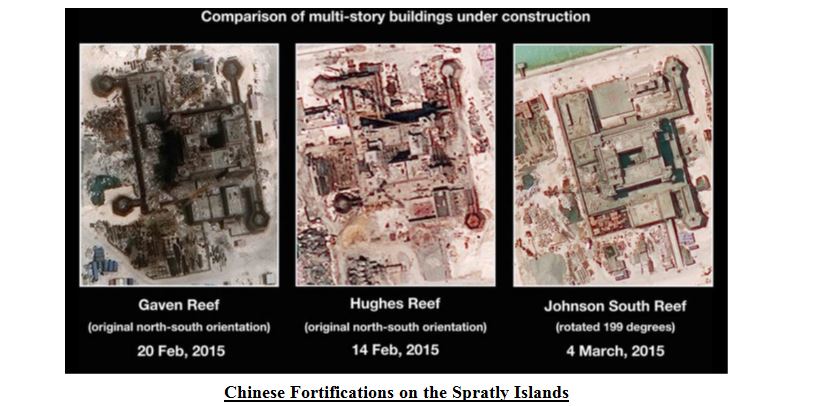Alistair Pope Beijing and the South China Sea
For all nations, except China, the South China Sea has long been regarded as a local ‘lake’ available to all for fishing, transit and, more recently, for the possible economic exploitation of the gas and oil deposits that have been detected. Although they have not been accurately quantified, about 7.7Bn barrels of recoverable oil has been identified with a potential for 28Bn barrels in total. This treasure trove is augmented by 266 trillion cubic feet of Natural Gas reserves. In 2014, China began to drill for oil in waters near the Paracel Islands that are disputed with Vietnam. This immense potential wealth has greatly raised the stakes for all claimants to the archipelagos and the surrounding seas.
As China has grown in economic and military power, the South China Sea has become both Beijing’s front line for naval defence and a limitation to its global projection of its power, as the island states to its east limit its access to the open waters of the Pacific Ocean. To be recognized as a world naval power the Chinese Navy (PLAN) must control both the South China Sea and the egress from it. This is the real basis for the aggressive Chinese claim to almost the whole of the sea, in some parts nearly to the shorelines of the littoral nations. Gaining control of these blue-water exits is also one reason for the Chinese government’s recent, more accommodating political relationship with Taiwan. This improved relationship has seen the unhindered transit of Chinese warships through the northern Taiwan Straits exit into the Pacific Ocean.
However, the Chinese government considers being allowed free transit as only a temporary solution, as it intends to achieve a military hegemony over the South China Sea and all the countries around it. When they are ready the Chinese Government will unilaterally impose restrictive rules and permit no infringements. Their intention is to use their dominance of the South China Sea to intimidate all the littoral nations into submission, in effect modern vassals states. By playing favourites with the flags of international ships they will also gain control of the global trade that must cross the sea. China is gambling that their unity, military capabilities and willingness to aggressively use their naval assets, when balanced against the lack of resolve and competing interests of the other claimants, will result in each individually surrendering to the Chinese claims in return for limited concessions.
As will be discussed later, in order to achieve this strategic aim the Chinese military has begun an extensive build-up on selected islands and shoals — actions most likely illegal under international law.
Geography & History of the South China Sea Islands
Collectively the South China Sea islands are mostly uninhabited low lying coral shoals without fresh water, arable land, edible plants or building materials. All the islands are subject to competing claims concerning territorial sovereignty by several countries. To support their claims each country uses different names for the islands and for the surrounding sea. Therefore, for each country the islands included or excluded in the two major archipelago of the Paracel and Spratly island groups differ, which further complicates the competing title claims to them.
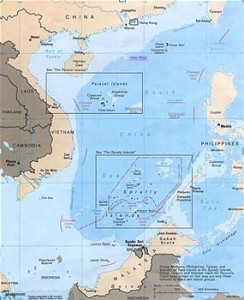 There are two major island groups of concern that may be the trigger for armed conflict: in the north, equidistant between China and Vietnam are the Paracel Islands, and in the south are the much more widespread and numerous Spratly Islands, which are close to the Malaysian States, Brunei and the Philippines, further from Vietnam and a long way from China. Singapore is closer to the nearest island in the Spratly Islands group than is China.
There are two major island groups of concern that may be the trigger for armed conflict: in the north, equidistant between China and Vietnam are the Paracel Islands, and in the south are the much more widespread and numerous Spratly Islands, which are close to the Malaysian States, Brunei and the Philippines, further from Vietnam and a long way from China. Singapore is closer to the nearest island in the Spratly Islands group than is China.
Geographically, the South China Sea is an extension of the Pacific Ocean. It encompasses an area from Singapore and curving east and north along the shores of the Malaysian States and Brunei on the island of Borneo (Kalimantan) up past the Philippines to the Straits of Taiwan with Taiwan Island forming the northern extremity. From the southern extremity at Singapore, an extension of the sea curves northwest along Malaysia and Thailand in the Gulf of Thailand, then south again past Cambodia before rounding the southern tip of Vietnam and then north along the coasts of Vietnam and China. The South China Sea covers an area of around 3.5M sqkm (1.4Msqmi) with its key central area directly bordered by seven countries, each claiming the littoral seas off their coast.
The ‘from shore’ territorial and economic claims to any one of the more than 750 islands in either the Paracel Islands in the north or the Spratly Islands archipelago in the south is that a successful claim to any one island would extend that claimant’s territorial control over a great part of the South China Sea. The problem is that the territorial claims to each and all the islands overlap each other so that occupation of one island naturally leads to a territorial dispute concerning any other islands in the vicinity (some of which are within sight of each other), and especially if they are occupied by another country. All of the claimant nations, except China, have adopted a conciliatory approach towards each other. Only the permanent occupation of a disputed island would be likely to result in hostilities.
Recently, the Chinese have unfortunately foregone diplomacy, conciliation and negotiation in favour of enforcing their unilateral claims by commencing the building of an extensive chain of powerful military fortresses on key islands.
UPDATE: US Navy Times confirms a carrier strike group is on its way “to confront China”
At different times in history the dominant regional or international naval powers have occupied or laid claim to individual islands or to whole archipelago. As the lines on the map above show, each of the modern littoral states has made relatively modest territorial and economic claims. Recently, this cooperative (if unresolved) question has been overwhelmed by the exceptionally aggressive claims made by China to the whole maritime area to within 80km of each of their individual coasts, and in some places the Chinese claims come within a mere 16km of the coast of sovereign countries.
 The Paracel Islands lie about 400 km east of central Vietnam and about 350 km southeast of Hainan Island, China. The Paracel archipelago is divided into the Amphitrite group in the northeast and the Crescent group in the southwest. The low, barren islands are tiny, lack fresh water and have never had permanent human residents. China, Taiwan, and Vietnam all claim the archipelago with China probably having the strongest claim.
The Paracel Islands lie about 400 km east of central Vietnam and about 350 km southeast of Hainan Island, China. The Paracel archipelago is divided into the Amphitrite group in the northeast and the Crescent group in the southwest. The low, barren islands are tiny, lack fresh water and have never had permanent human residents. China, Taiwan, and Vietnam all claim the archipelago with China probably having the strongest claim.
In addition to Chinese archaeological artefacts and graves having been located on the main island, the Government of Guangdong Province claimed the Paracel Islands in 1911. The Southern Military Government in 1921 reaffirmed the 1911 claim with China continuing to exercise authority over these islands by granting licenses or contracts to private Chinese merchants for the development and exploitation of guano and other resources on the islands, while simultaneously protesting against all foreign nations’ claims, occupations, and other activities.
However, Taiwan also has a good claim as they are the remnant of the Nationalist Chinese government that made the original claim. Although they were displaced by Mao in 1949, the Taiwanese continue to regard themselves as the ‘Chinese Government in Exile’, rather than the remains of a defeated and dispossessed army. Although Taiwan has registered its claim to the Paracel Islands it has neither the military, nor logistic capability needed to exercise any rights to the area.
Taking advantage of the Chinese Civil War, French Indochina announced the annexation of the Paracel’s in 1932 as part of their Indochinese colony. To reinforce their claim they established a weather station on the main island.
By right of conquest, Japan occupied some of the islands during World War II (1941–45) but later withdrew and renounced all of its claims in 1951. In 1947 Chinese Nationalist troops occupied Woody Island, the main island of the Amphitrite group. On Prattle Island, the largest of the Crescent group, the original weather station continued to be operated by French Indochina and its successor, Vietnam. With the political separation of the two China’s and two Vietnam’s, the number of claimants doubled: while the People’s Republic of China and South Vietnam actually occupied the islands, Taiwan and North Vietnam declared themselves the legitimate heirs of prior Chinese and Vietnamese claims. In support of the Vietnamese claims, archaeologists found evidence of their occupation in past centuries.
The Spratly Islands
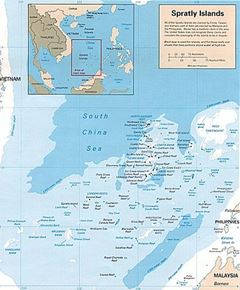 The location and wide geographic spread of the Spratly Islands greatly complicates the myriad claims to them, so the issue of ownership of the Spratly Islands cannot be decided on purely geographic grounds.
The location and wide geographic spread of the Spratly Islands greatly complicates the myriad claims to them, so the issue of ownership of the Spratly Islands cannot be decided on purely geographic grounds.
Given the complicated geography and history of the islands, there are only three realistic options for settling the claims to them:
- the islands mainly remain an international possession with some economic and territorial concessions granted to individual nations based on geography and proven history, but without conceding exclusive sovereignty;
- international conciliation in which all claimants present their claims and agree to the arbitrated judgment that grants sovereignty; or
- a military power unilaterally takes what it wants.
Option 1 is the preferred option of most of the claimants and the USA as it allows continued free passage for all nations ships and a sharing of the economic assets in a reasonably rational way.
Option 2 is unlikely, as a loss in a court of international law would see a permanent loss of rights. This is why Option 1 remains the preference of everyone, except China.
Option 3 is the most dangerous option, but is in fact what is happening in line with the seven powerful fortresses under construction by China.
Recent Hostilities
Although both France and Japan had occupied the Paracel Islands between 1932 & 1945, the transfer of power between them had been bloodless. At the end of WW2, the occupying Japanese soldiers also surrendered without a fight. Since 1949, China and Vietnam actively prosecuted their claims to the islands, and both China and South Vietnam sporadically occupied and controlled individual islands. In 1974, this resulted in a naval and military clash that became known as the Battle of the Paracels. China defeated the South Vietnamese, though both sides took significant casualties in proportion to the forces engaged. In reaction to the South Vietnamese government signing contracts with foreign oil companies to exploit oil and gas deposits, China attacked the islands from the sea and air, captured the weather station crew, and assumed control of the entire archipelago.
On January 16, 1974, a South Vietnamese frigate was sent to the Paracels on a reconnaissance mission. They discovered several Chinese vessels near Drummond Island and observed Chinese soldiers on nearby Duncan Island. The South Vietnamese Navy immediately dispatched two naval vessels and some marines to evict the Chinese ships and soldiers. On their arrival, the South Vietnamese Task Force and the Chinese forces confronted and shadowed each other, but did not engage. The following day the South Vietnamese occupied Robert Island. Both sides next received reinforcements and continued to keep a watchful eye on each other. Finally, on January 18, the commander of the South Vietnamese fleet, Colonel Hà Văn Ngạc, arrived on a frigate escorted by a corvette which, as it happened, had only one functioning engine.
Both sides now had four warships available and two more Chinese submarine chasers were on the way. Unknown to the assorted company of South Vietnamese soldiers, they were opposed by two full strength PLA marine battalions plus a number of irregular militia spread over several islands.
On the morning of January 19, South Vietnamese soldiers landed on Duncan Island and immediately came under fire. Three Vietnamese soldiers were killed and several injured. Finding themselves outnumbered, the Vietnamese withdrew by landing craft. To protect their soldiers the small South Vietnamese fleet drew close to the Chinese warships in a tense standoff.
In the battle that followed, four ships took part from each side, but the total displacement and weapons of Vietnamese ships was superior to those of available to the Chinese. The reinforcement forces sent by China’s PLAN did not reach the area in time to take part in the battle.
At 10:24 a.m., the Vietnamese warships opened fire on the Chinese warships. Despite the range and their superior weaponry, the Vietnamese failed to inflict crippling damage on the smaller Chinese warships, which then managed to move into the blind spots of the guns on the Vietnamese warships and retaliated by damaging all four Vietnamese ships. The frigate acting as the Vietnamese flagship could not withdraw because her remaining engine was disabled. The crew was ordered to abandon ship but her captain, Lt. Commander Ngụy Văn Thà, remained on board and went down with his ship. The remaining ships were severely damaged and retreated westwards. The fire fight had lasted about 40-minutes, with both sides receiving significant damage. When battle was engaged, the South Vietnamese Government requested the assistance of the U.S. 7th Fleet, but the request was denied.
The next day, Chinese ground-attack aircraft bombed the three islands under Vietnamese control and a landing was made on each that resulted in the surrender of the South Vietnamese Marine garrison. The damaged Vietnamese navy ships withdrew to Da Nang and China’s to Hainan.
One South Vietnamese ship had been sunk and all of the other seven ships engaged in the battle were damaged. Over 70 soldiers had been killed, 53 of them South Vietnamese. The real outcome was that China gained unchallenged control over all the Paracel Islands which it has maintained to the present day.
Both sides then issued totally conflicting reports of the causes and course of the battle. It was more than twenty years before a reasonably truthful picture emerged.
 In March, 1988, Johnson South Reef in the Spratly Islands was the site of a naval clash, in which over seventy Vietnamese sailors were killed and three Vietnamese armed transports were destroyed. Since that time there have been numerous minor clashes. Despite the desire of most of the claimants to ensure that the territorial disputes within the South China Sea do not escalate into a major war, it is becoming more probable that a major clash will happen sooner, rather than later.
In March, 1988, Johnson South Reef in the Spratly Islands was the site of a naval clash, in which over seventy Vietnamese sailors were killed and three Vietnamese armed transports were destroyed. Since that time there have been numerous minor clashes. Despite the desire of most of the claimants to ensure that the territorial disputes within the South China Sea do not escalate into a major war, it is becoming more probable that a major clash will happen sooner, rather than later.
As the map (right) shows, the occupation of various Spratly Islands has become a complex tapestry for which there is no easy solution — or exit — for any participant.
Despite seven nations establishing a Joint Development Authority to arbitrate overlapping claims and to jointly develop the area by proportionally dividing the profits from exploiting its assets, this is still a very temporary solution that simply buys time. Unfortunately, that time is being used by the Chinese to build the means to enforce their dream of hegemony as the JDA is about economics and not about settling the issue of sovereignty over the area.
Chinese Militarization of the South China Sea
Many times in the past nations have seized some key islands, but the diminutive size, lack of natural resources and constant need for total logistic support has always limited their effectiveness as bases for aggressive military purposes. That was the past, but this time Chinese aims go well beyond the purely territorial or economic wealth that lies beneath the islands. Their main driving force is regional domination of weaker neighbours so they can erase (what they see) as centuries of humiliation by foreign powers, particularly Japan and the European traders. Their intention is to create a regional Chinese hegemony in which everyone else around “their” inland sea is a vassal. If they succeed, every nation around the South China Sea and all nations whose ships pass through the region will have to ask for Chinese permission.
Island Building & Fortresses
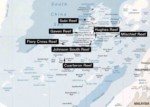 China has begun an extensive island building program on seven reefs (left). All of these new islands are being extensively fortified and the major one at Fiery Cross Reef has a runway capable of taking all military aircraft, not just logistical resupply transports. their intention is clearly to dominate the shipping lanes and prevent any littoral states naval vessels or planes from entering what will have effectively become a Chinese lake. Beijing has already warned the U.S. Seventh Fleet to stay out of ‘Chinese Territory’. The Chinese are going to a great deal of trouble and expense with their version of the Maginot Line, yet their Foreign Ministry has stated that the structures are for “humanitarian, scientific and environmental purposes’. Apparently, to paraphrase Mao, humanitarian power grows from the barrel of a gun?
China has begun an extensive island building program on seven reefs (left). All of these new islands are being extensively fortified and the major one at Fiery Cross Reef has a runway capable of taking all military aircraft, not just logistical resupply transports. their intention is clearly to dominate the shipping lanes and prevent any littoral states naval vessels or planes from entering what will have effectively become a Chinese lake. Beijing has already warned the U.S. Seventh Fleet to stay out of ‘Chinese Territory’. The Chinese are going to a great deal of trouble and expense with their version of the Maginot Line, yet their Foreign Ministry has stated that the structures are for “humanitarian, scientific and environmental purposes’. Apparently, to paraphrase Mao, humanitarian power grows from the barrel of a gun?
Each fortress is extensively clad in reinforced concrete capable of withstanding direct hits by most missiles, iron bombs and guns. The pentagonal towers will house retractable automatic, radar controlled missiles or anti-aircraft guns. No regional power has anything in its armoury capable of successfully attacking these fortifications.
The land surface of Fiery Cross Reef has trebled in size since dredging for the island building was begun. Of greater interest are the military structures being erected on these new island fortresses. The satellite photo 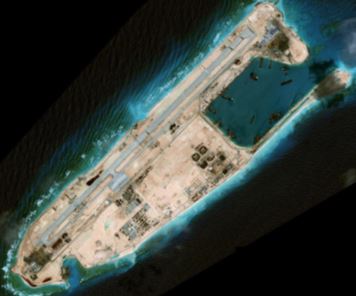 (right) shows the type of fortifications being erected.
(right) shows the type of fortifications being erected.
When the forts are fully armed, stocked with a year’s provisions and operational, China will close the door and announce their hegemony over the whole of the South China Sea. Having announced their position and the rules they will apply to all ships and aircraft entering the newly acquired territory they have unilaterally seized it can be expected that they will deliberately instigate a series of incidents to humiliate their ‘vassals’ and the USA. This will include seizing fishing boats ‘illegally’ fishing without permission, arresting and impounding dozens of cargo ships (which will only be released after paying hefty fines or forfeiting their cargoes) and banning passage to ships flying ‘unfriendly’ flags or transiting to any Japanese port. The Chinese will deliberately prod and provoke both Japan and the USA to test their reaction. They will test the resolve of the USA by threatening to take ‘decisive measures’ if there is an ‘unauthorised incursion’ by any warship from the U.S. Seventh Fleet.
Simultaneously, overwhelming forces will in turn be employed to remove every other nations outposts and military or civilian occupation of islands. The few Spratly Islands that have recently gained permanent inhabitants will be depopulated.
Fight or Flee or …. What?
In his book “Australian Defence” David Archibald (see bibliography) believes that China will steadily escalate the provocations until the USN either fights or flees. If the USA fights, then with the Seventh Fleet operating in the confined space of the South China Sea and with seven heavily fortified islands restricting their free movement, victory for the technologically superior USN is by no means certain. On the other hand, victory for the Chinese would require only a limited, positive result with David surmising: “Ideally, for the Chinese, they would like to sink an aircraft carrier and then call a halt to hostilities. The United States’ influence would shrink back to Hawaii and then China would be able to do whatever it wanted in Asia.”
The new Chinese fortresses are so powerful that only the USN can confront them, albeit with the aid, support and commitment of the nations that would otherwise be the biggest losers. When push comes to shove, only the US can match China in the South China Sea.
However, China is playing a dangerous game of brinkmanship. Given its obsessive desire to redress what Beijing sees as their humiliating history (there is even a ‘National Humiliation Day’!) combined with the Asian psyche, China cannot back down in the Spratlys without losing face – therefore a war on some scale is probably inevitable. Chinese hatred for their humiliation at the hands of the Japanese 80 years ago still dominates their thinking, so provocation and escalation until war with Japan, or with an alliance of the Japanese and the U.S., seems a reasonable option to the Chinese leadership.
If the U.S. does not step up and confront this aggression early, then Japan will be compelled to obtain nuclear weapons as soon as possible as their only protection against China. Japan has already changed its Constitution to allow the build-up of their navy and for their military to once again be deployed in overseas conflicts.
It is also possible that Japan will independently aid its neighbours anddirectly respond to the attempted takeover of the Spratlys and the South China Sea by sending powerful naval forces to patrol the shipping lanes in conjunction with the affected states.
The likelihood of a series of ‘independent’ naval battles by relatively small forces is high.
The First Moves
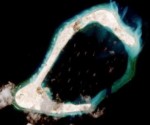 In their first move challenging Chinese hegemony, the U.S. guided-missile destroyer the USS Lassen patrolled through the South China Sea and deliberately went within the 12-mile limit of Subi Reef (left), one of seven artificial island fortresses built up by China in the past year.
In their first move challenging Chinese hegemony, the U.S. guided-missile destroyer the USS Lassen patrolled through the South China Sea and deliberately went within the 12-mile limit of Subi Reef (left), one of seven artificial island fortresses built up by China in the past year.
The USS Lassen was on a “freedom-of-navigation” patrol that an official of the U.S. government said was expected to become more frequent. In retaliation, China called in the U.S. Ambassador, Max Baucus, telling him that the patrol was ‘extremely irresponsible’. The Chinese Foreign Ministry claimed that the USS Lassen “illegally” entered waters near the islands and rebuked the Ambassador, saying it had tracked and warned the ship about ‘entering Chinese territory’. The USS Lassen’s patrol was the most significant U.S. challenge yet even though this single patrol, traversed just a 115 km passage. A Chinese guided-missile destroyer and a naval patrol ship shadowed the Lassen and gave warnings “according to law”, China’s Defense Ministry said.
As any excuse will do, Chinese Foreign Ministry spokesman, Lu Kang, warned that, “if the United States continues to create tensions in the region, China might conclude it had to increase and strengthen the build up of our relevant abilities”. Lu did not elaborate, but his comments suggest that China could use this little patrol as an excuse to further boost its military presence in the South China Sea. In the bizarre world of diplomacy the Chinese claimed that the patrol by the Lassen was a “coercive action that seeks to militarize the South China Sea region” and an “abuse” of freedom of navigation under international law. This game of diplomatic mirrors ignores, amnongst other things, that Chinas have provocatively anchored an armed ship in Malaysian waters for more than two years! Simply put, China appears determined to manufacture a scenario that will provide the required incident, no matter how flimsy the excuse.
The next conventional war in Asia may be closer than we think and a few shoals and small islands in the South China Sea might be the unlikely hot spot that sets the region ablaze.
Alistair Pope retired from the Australian Army in 1986 as a Lieutenant Colonel. He served in various postings in Australia, Vietnam, Indonesia and Papua New Guinea and now works as an international project management consultant
Comments are closed.

